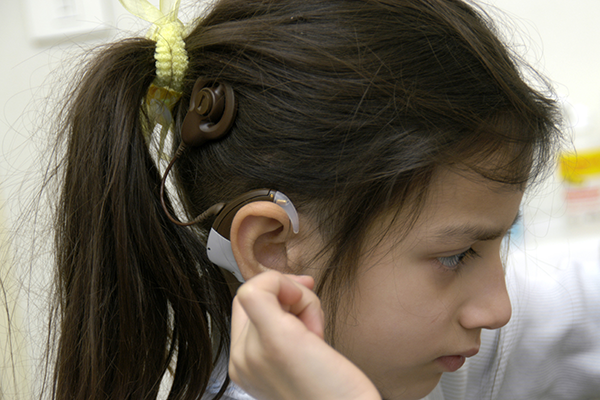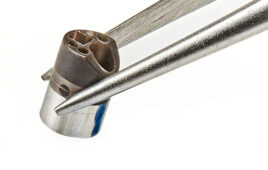Your elderly uncle is hard of hearing and has a difficult time understanding conversation — so much so that he’s feeling frustrated and left out. His hearing aids aren’t helping much.
Your one-year-old daughter was diagnosed with severe hearing loss in both ears, and you’re worried about her ability to learn and understand speech. How will she learn to communicate?
For both of these cases, a cochlear implant may be an option.
What are cochlear implants? Who uses them and why? And how does the U.S. Food and Drug Administration (FDA) play a role? The cochlea is the part of the inner ear that contains the endings of the nerve which carries sound to the brain. A cochlear implant is a small, electronic device that when surgically placed under the skin, stimulates the nerve endings in the cochlea to provide a sense of sound to a person who is profoundly deaf or severely hard of hearing.
“A severe to profound hearing loss in both ears prevents a person from understanding speech and communicating in everyday conversations. Cochlear implants can increase hearing and communication abilities for people who don’t receive enough benefit from traditional hearing aids,” says Srinivas Nandkumar, Ph.D., chief of the Ear, Nose and Throat (ENT) Devices Branch at FDA.

(Credit: FDA)
How Does It Work?
A cochlear implant consists of an external part that sits behind the ear and an internal part that is surgically placed under the skin. Usually, a magnet holds the external system in place next to the implanted internal system. The FDA has approved cochlear implants for use by individuals aged one year and older.
Here’s how it works:
- A surgeon places the cochlear implant under the skin next to the ear.
- The cochlear implant receives sound from the outside environment, processes it, and sends small electric currents near the auditory nerve.
- These electric currents activate the nerve, which then sends a signal to the brain.
- The brain learns to recognize this signal and the wearer experiences this as “hearing.”
“A cochlear implant is quite different from a typical hearing aid, which simply amplifies sound,” says Nandkumar. “Using one is not just a matter of turning up the volume; the nerves are being electrically stimulated to send signals and the brain translates and does the rest of the work.” Moreover, cochlear implant wearers need to undergo intensive speech therapy to understand how to process what they are hearing.
Cochlear implants don’t restore normal hearing, says Nandkumar. But depending on the individual, they can help the wearer recognize words and better understand speech, including when using a telephone.
Does Age Matter?
According to the National Institute on Deafness and other Communication Disorders (NIDCD) at the National Institutes of Health (NIH), for young children who are deaf or severely hard-of-hearing, using a cochlear implant while they are young exposes them to sounds during an optimal period to develop speech and language skills. Several research studies have shown that when these children receive a cochlear implant at a relatively young age (for example, at 18 months) followed by intensive therapy, they tend to hear and speak better than those who receive implants at an older age.
But adults and older children who have acquired severe to profound hearing loss after they have acquired speech can also do very well with an implant, partly because they are post-lingual (that is, already have learned to speak a language). “At that point, a person has to get used to the fact that what he hears sounds differently and more ‘machine-like’ than it did when he had more hearing,” Nandkumar says. “Whereas someone who was profoundly deaf at birth will adapt at a very early age to a cochlear implant and the way in which it processes sound.”
Conversely, people who are deaf since birth and have not gotten implants until they are a bit older (for example, 8 years of age) may not derive as much benefit from cochlear implants.
FDA Regulation of Cochlear Implants
Before manufacturers can bring a new cochlear implant to market, they must submit studies and data to FDA scientists, who will review the information for safety and effectiveness. Cochlear implants are designated as Class III devices, meaning they receive the highest level of regulatory scrutiny. This is because they are surgically implanted near the brain, which increases health risk. Other risks, while minimal, include injury to the facial nerve, meningitis , perilymph fluid leak (fluid from the inner ear leaks through the hole created to place the implant), and dizziness or vertigo.
The Future of Cochlear Implants
Scientists continue to look for ways to improve cochlear implants and how they function once implanted. For example:
- Companies are developing more sophisticated strategies that help to minimize background noise and increase the noise-to-sound ratio, helping the user to better focus and understand speech.
- Hearing science researchers also are looking at the potential benefits of pairing a cochlear implant in one ear with either another cochlear implant or a hearing aid in the other ear.
“A cochlear implant won’t restore hearing the way that eyeglasses can fully restore vision,” Nandkumar says. “But companies are developing increasingly sophisticated processing strategies that can reduce background noise and increase the signal-to-noise ratio, in an effort to improve the quality of speech the wearer hears.”
This article appears on the FDA’s Consumer Updates page, which features the latest on all FDA-regulated products.




